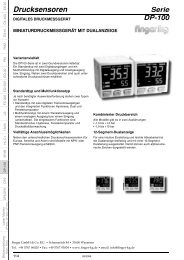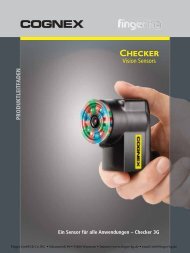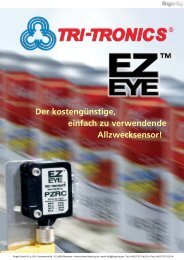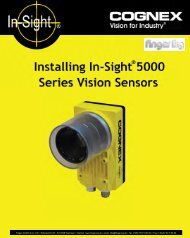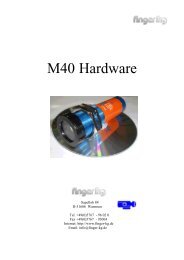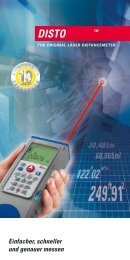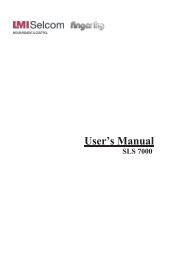TRIANGULATION LASER SENSORS, LDS603 Series Rev. G (26.06 ...
TRIANGULATION LASER SENSORS, LDS603 Series Rev. G (26.06 ...
TRIANGULATION LASER SENSORS, LDS603 Series Rev. G (26.06 ...
You also want an ePaper? Increase the reach of your titles
YUMPU automatically turns print PDFs into web optimized ePapers that Google loves.
<strong>TRIANGULATION</strong> <strong>LASER</strong> <strong>SENSORS</strong>, <strong>LDS603</strong> <strong>Series</strong><br />
- Time Sampling or<br />
- Trigger Sampling<br />
With sampling by time selected, the sensor automatically transmits the measurement result via<br />
serial interface in accordance with selected time interval (sampling period).<br />
With sampling by external input is selected, the sensor transmits the measurement result when<br />
external synchronization input is switched and taking the division factor set into account.<br />
Range of the analog output (beginning and end of the range of analog output). While working<br />
with the analog output, resolution can be increased by using the ‘Window in the operating range’<br />
function which makes it possible to select a window of required size and position in the operating<br />
range of the sensor within which the whole range of analog output signal will be scaled.<br />
If the beginning of the range of the analog signal is set at a higher value than the end value of the<br />
range, this will change the direction of rise of the analog signal.<br />
Analog output operation mode . When using ‘window in the operating range’ function, this<br />
mode defines the analog output operation mode.<br />
Analog output can be<br />
- in the window mode or<br />
- in the full mode.<br />
‘Window mode’. The entire range of the analog output is scaled within the selected window. Outside<br />
the window, the analog output is "0".<br />
"Full mode". The entire range of the analog output is scaled within the selected window (operating<br />
range). Outside the selected window, the whole range of the analog output is automatically scaled<br />
onto the whole operating range of the sensor (sensitivity range).<br />
Logical output mode and mutual synchronization mode.<br />
Logical output can be used for<br />
- indication of run-out beyond the range ("0" – object is beyond the range (beyond the selected<br />
window in the range), "1" – object is within the range (within the selected window in the<br />
range)<br />
- mutual synchronization of two or more sensors.<br />
Selection of the mutual synchronization mode makes it possible to synchronize measurement<br />
times of two and more sensors. This mode is convenient to use for control of one object with several<br />
sensors, for example, when thickness is to be measured. On hardware level, sensor synchronization<br />
is carried out by combining AL lines.<br />
Time of lock of the result. If the sensor does not find out object or if the authentic result cannot<br />
be received, zero value is transferred. The given parameter sets time during which is transferred the<br />
last authentic result instead of zero value<br />
Number of averaged values specifies the number of source results to be averaged for deriving<br />
the output value. Source data are stored in a circular buffer, and new mean value is calculated each<br />
time the new result arrives; therefore, the output may regarded as a moving average.<br />
The refreshment of the result through the analog output is also controlled by the two parameters<br />
described above.<br />
Time limit for integration. Intensity of the reflected radiation depends on the surface quality of<br />
objects under control. Therefore, the time of integration of radiation incident onto the CMOS-array<br />
is automatically adjusted to achieve maximum measurement accuracy. This parameter specifies<br />
maximum allowable time of integration. If the radiation intensity received by the sensor is so small<br />
that no reasonable result is obtained within the time of integration equal to the limiting value, the<br />
sensor transmits a zero value. Increasing of this parameter expands the possibility of control of lowreflecting<br />
(diffuse component) surfaces; at the same time this leads to reduction of data refreshment<br />
rate and increases the effects of exterior light (background) on the measurement accuracy. Factory<br />
setting of the limiting time of integration is 1300 us.<br />
Page 4/22<br />
<strong>Rev</strong>. G (<strong>26.06</strong>.2008)<br />
Finger GmbH & Co. KG • Schamerloh 84 • 31606 Warmsen • Internet: www.finger-kg.de • email: info@finger-kg.de



